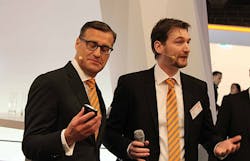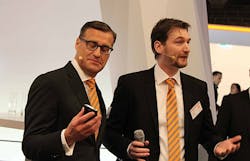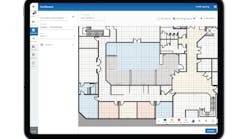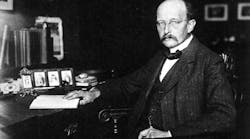In the latest IoT salvo among lighting companies, Osram chooses Bluetooth where Philips is pushing visible light communications.
FRANKFURT - Osram today set off a technology battle in the nascent market for lighting-based indoor positioning systems as it announced a pilot product based on Bluetooth rather than on the flickering waves of visible light communications (VLC) favored by Dutch rival Philips.
Interested in more articles & announcements on indoor positioning?
CEO Olaf Berlien helped unveil the new location-based navigation system at the Light+Building exhibition here today, where he participated in a live demo led by Christoph Peitz, the director of smart lighting solutions in Osram's Innoventures group, a technology development unit.
The new technology, called Einstone, embeds a Bluetooth beacon inside a ceiling luminaire to make contact with smartphones. Indoor positioning systems engage end users such as shoppers in places like physical world retail stores with information that helps direct them around shop floors and offers them deals, discounts, and product information.
It's all new to Osram CEO Olaf Berlien (l), as he and the company's director of smart lighting solutions Christoph Peitz get ready to test drive Osram's Bluetooth-based lighting-to-smartphone indoor positioning system, called Einstone. The demo went smoothly. (Source: Mark Halper.)
“The idea is to connect the real world around the lighting installation on the one hand with the digital world on your smartphone,” said Peitz.
CEO Berlien and Peitz showed an app tailored to direct blind people around unfamiliar places by causing their phone to vibrate with alerts and by quickly speaking directions and warnings to them. Peitz told LEDs Magazine that Osram is trialing that particular app with visually impaired employees at Osram headquarters in Munich.
He described many other possible uses for the indoor positioning technology, such as allowing shoppers in retail stores to page an expert on a product in front of them; delivering information at museums straight to users' smartphones rather than relying on museum-issued audio guides; prompting sales people to talk about a particular object on tour; and soliciting immediate feedback from shoppers or users of a facility who could report problems in real time.
Osram is running small trials with a parking garage in Munich to help locate cars for people who have forgotten. It is also piloting Einstone with a Munich office building to help locate rooms.
The system also allows users to control lights via their phones.
“We could bring this into smart cities as well as into building, retail, hotels, exhibitions,” said Peitz. “Every light will become a GPS signal.”
In fact, from an indoor perspective, lighting-based location trumps GPS, which does not work well indoors.
As Berlien noted, “GPS doesn't give you 3D — it doesn't know what floor you're on.”
Proponents of lighting-based indoor positioning systems don't all agree, however, on which indoor technology to use.
Philips is working on one called visible light communication, which embeds data in the modulating, flickering wavelengths of LED lights. Yesterday, it announced a new VLC trial with Dubai retailer aswaaq, following a similar trial with a Carrefour store in France (linked earlier in this story). VLC provides greater pinpoint location accuracy than does Bluetooth.
In the US, retail giant Target is trialing both VLC and Bluetooth beacons, although it's not clear if their Bluetooth implementation embeds the beacons in luminaires. Stores can mount beacons anywhere, not necessarily in lighting.
Geert van der Meer, CEO of the Digital Systems group within Osram's Lighting, Solutions and Systems (LSS) business unit, told LEDs Magazine that the company opted for Bluetooth beacons rather than VLC because Bluetooth does not require direct line of sight between a phone and a ceiling luminaire, and because VLC requires more luminaires than does Bluetooth. Osram is working with beacons from Apple, he said.
But why embed Bluetooth beacons in a luminaire rather than mount them elsewhere in a store? Because, van deer Meer explained, the beacons can run on electricity drawn directly from the luminaire connection instead of relying on battery power, which often fails in store implementations.
Along with the Luminaires division within LSS, his group has been helping Peitz' team develop it. Both the Luminaires group and Van der Meer's Digital Systems group are possible users of Einstone. The Digital System group markets smart lighting technologies to fixture manufacturers, with the aim of tying lighting into other building systems such as heating and cooling, and helping lights gather data about building occupancy that leads to smarter choices about how to use rooms and property.
Van der Meer described the Digital Systems group as “an IoT enabler,” to which Einstone could contribute.
Another possible user is Osram's for-sale lamps division, which in July will legally separate from the rest of Osram, under the name LEDVANCE. As a visual reminder of the split, Osram recently removed the bulb from its corporate logo, which now just has the company name. It's all part of the lighting industry's general “beyond illumination” push into connected lighting and services, in which lights will become important nodes in data collection, distribution, and analytics.
“We have companies coming to talk to us who we would never have imagined,” Peitz said, noting that Osram is in various levels of talk with software outfits and startups.
Meanwhile, Osram did not provide any further details on its efforts to sell off the lamps division.
MARK HALPERis a contributing editor for LEDs Magazine, and an energy, technology, and business journalist ([email protected]).






